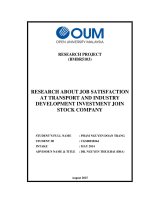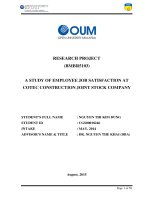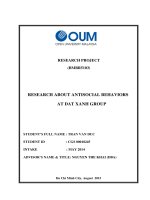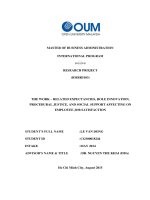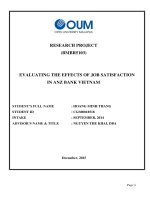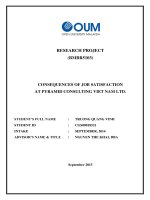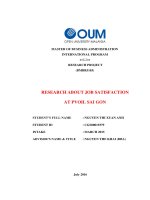Research about job satisfaction at PG bank (vietnam)
Bạn đang xem bản rút gọn của tài liệu. Xem và tải ngay bản đầy đủ của tài liệu tại đây (1.18 MB, 61 trang )
MASTER OF BUSINESS ADMINISTRATION
INTERNATIONAL PROGRAM
RESEARCH PROJECT
(BMBR5103)
RESEARCH ABOUT JOB SATISFACTION
AT PG BANK (VIETNAM)
STUDENT’S FULL NAME
: PHAN BA PHUONG
STUDENT ID
: CGS00019372
INTAKE
: MARCH 2015
ADVISOR’S NAME & TITLE
: NGUYEN THE KHAI (DBA)
ADVISOR’S ASSESSMENT
..…………………………………………………………………………………………………………
..…………………………………………………………………………………………………………
..…………………………………………………………………………………………………………
..…………………………………………………………………………………………………………
..…………………………………………………………………………………………………………
..…………………………………………………………………………………………………………
..…………………………………………………………………………………………………………
..…………………………………………………………………………………………………………
..…………………………………………………………………………………………………………
..…………………………………………………………………………………………………………
..…………………………………………………………………………………………………………
..…………………………………………………………………………………………………………
ADVISOR’S SIGNATURE
..…………………………………………………………………………………………………………
..…………………………………………………………………………………………………………
..…………………………………………………………………………………………………………
..…………………………………………………………………………………………………………
NGUYEN THE KHAI (DBA)
ACKNOWLEDGMENTS
Suggestions have been received from many of my lecturer and classmate during
research progress.
Each of those who have offered comments and suggestions always has my thanks.
The efforts of many people are needed to develop and improve this research.
Among these people are the reviewers and consultants who point out areas of
concern, cite areas of strength, and make recommendations for change.
I am grateful for the outstanding support from my lecturer NGUYEN THE KHAI
(DBA) and PG Bank for permission the employees answer the questions in the
survey and support too much information related to my research.
And, I also specially thank to my members of family, friends and colleagues
always mobilize me to finish this research.
Once again, I thank very much to all.
Phan Ba Phuong Student
CONTENTS
PART ONE
ABSTRACT
1
INTRODUCTION
2
1
About PG Bank
2
2
Organization structure and Corporate culture
6
Mix organizational structure
6
Achievements
7
Strategy Shareholders
7
Corporate culture
8
3
Research problem statement
9
4
Research objective
10
5
Research scope
11
7
Significance of research
11
PART TWO
8
9
LITERATURE REVIEW
12
Definition of Constructs
12
Job Satisfaction
12
Job Cognitions
13
Distributive, Procedural, Interactive Justice
14
Perceived Person – Organization Fit
14
Perceived Importance of Workplace values
16
Argument for the relationship among the constructs
17
X theory and Y theory
17
Maslow’s theory
20
Alderfer’s ERG theory
22
McClelland’s theory
24
Herzberg’s two-factor theory
25
Hackman and Oldham's Job Characteristics
27
10
Hypotheses
29
11
Research model
30
PART THREE
12
13
PART FOUR
14
15
16
PART FIVE
METHODS
30
Data collection
30
Design template scale
30
Data collection progress
33
Data analysis
34
RESULTS
34
Cronbach’s Alpha
34
Cronbach’s Alpha standard applied
34
Cronbach’s Alpha of constructs
35
Statistics information
36
Descriptive statistics
36
Correlation statistics
37
Hypotheses testing
38
Hypothesis proposed (H1)
39
Hypothesis proposed (H2)
39
Hypothesis proposed (H3)
40
Hypothesis proposed (H4)
41
CONCLUSIONS
42
17
Discussion
42
18
Limitation of research
43
19
Forecast recommendation
43
REFERENCES
44
47
APPENDIX
Appendix 1: Survey
47
Appendix 2: Presentation
52
FIGURE & TABLE
FIGURE
Figure 1
Maslow's hierarchy of needs
21
Figure 2
Alderfer’s ERG theory
23
Figure 3
McClelland’s theory
24
Figure 4
Herzberg’s two-factor theory
26
Figure 5
Hackman and Oldham's Job Characteristics
29
Figure 6
Research model of Job Satisfaction
30
Table 1
Job Satisfaction Scale
31
Table 2
Satisfaction with Job cognitions Scale
31
Table 3
Distributive, Procedural, Interactive Justice Scale
32
Table 4
Perceived Person – Organization Fit Scale
32
Table 5
Perceived Importance – Workplace Values Scale
33
Table 6
Time table for data collection progress
34
Table 7
Cronbach’s Alpha - Internal Consistency
35
Table 8
Cronbach’s Alpha of Job Satisfaction
35
Table 9
Cronbach’s Alpha of Job Cognitions
35
TABLE
Table 10
Cronbach’s Alpha of Distributive, Procedural, Interactive Justice
Table 11
Cronbach’s Alpha of Perceived Person – Organization Fit
Table 12
Cronbach’s Alpha of Perceived Importance – Workplace Values
Table 13
Descriptive statistics
37
Table 14
Correlation statistics
38
Table 15
Model summary of H1
39
Table 16
Coefficients of H1
39
Table 17
Model summary of H2
39
Table 18
Coefficients of H2
40
Table 19
Model summary of H3
40
Table 20
Coefficients of H3
40
Table 21
Model summary of H4
41
Table 22
Coefficients of H4
41
35
36
36
Business Research Methods
P a g e 1 / 55
ABSTRACT
T
his purpose of this research is way to find the factors influence to the Job
Satisfaction of employees working at PG Bank.
This research project will use Business Research Methods to determine
Job Satisfaction and what other main factors that it influence job satisfaction. And this
research also was conducted by quantitative method with source data is surveys that it
issued by offline to 500 employees of PG Bank to collect the ideas and comments of
employees about job satisfaction.
Next, the result of these surveys shall be statistically analyzed by software SPSS
version 22 (copyright of IBM). Hypotheses used this research includes five constructs:
one dependent construct (Job Satisfaction) and four independent constructs (Job
Cognitions; Distributive, Procedural, Interactive Justice; Perceived PersonOrganization Fit; Perceived Importance of Workplace values)
I hope results of this research will help the CEO; managers of PG Bank have some
reference angle in human resource management to improve and increase our quality
resource based on job satisfaction of employees as well as you should have perception
clearly that job satisfaction of employees will impact to working effective, ability of
competitiveness of the company on banking and financial sector Vietnam market.
Key words in this research: Overall Job Satisfaction, Job Cognitions; Distributive,
Procedural, Interactive Justice; Perceived Person; Perceived Importance and PG
Bank.
Student: Phan Ba Phuong (ID: CGS00019372)
Business Research Methods
P a g e 2 / 55
PART ONE: INTRODUCTION
About PG Bank
History
Petrolimex Group Commercial Joint Stock Bank (PG Bank), formerly known as Dong
Thap Muoi Rural Joint Stock Bank, was established on 13th Nov 1993 with initial
chartered capital of VND 700 million. After nearly 20 years of operation, the Bank has
developed steadily and succeeded in building up customers trust. From 2005, with the
participation of strategic shareholder, which is Vietnam National Petroleum Group
(Petrolimex), PG Bank experienced outstanding achievements, in terms of both
operating scale and effectiveness. The year 2007 marked a significant development
milestone of PG Bank by the transformation to urban bank model which is sound step
forward on the road to become a leading Vietnamese universal bank.
•
December 2011: Officially launching new Head quarter in Mipec Tower, 229
Tay Son (Hanoi).
•
August 02, 2012: Chartered capital officially increased to VND 3,000 billion
•
May 2013: Flexipay - money transfer service was launched at Petrolimex's
petrol stations.
•
June 2013: Visa Credit Card was rolled out.
•
December 2013: PG Bank was extended the operating license to 99 years from
13/11/1993 according to the Decision of the State Bank of Vietnam on amending the
contents of the Operating License.
Student: Phan Ba Phuong (ID: CGS00019372)
Business Research Methods
P a g e 3 / 55
Products and Services
PG Bank provides a comprehensive range of traditional banking products and services,
including deposit and lending products, cross-border remittance service, trade
financing and card-related services. In addition, the Bank has also put great effort in
developing and offering customers more diversified and advanced financial products
and services, notably corporate finance and commodity derivatives.
Information System
The Internet Banking service of PG Bank has been enhancing continuously in recent
years, allowing customers to conveniently make banking transactions on the Bank’s
portal with personal information being kept at strictest confidential. To ensure best
Student: Phan Ba Phuong (ID: CGS00019372)
Business Research Methods
P a g e 4 / 55
support possible to all the operations of the Bank, in recent years PG Bank has
invested heavily on the information system. At the moment, PG Bank is utilizing
FlexCube, the corebanking system provided by Oracle while using the advanced
information security system developed by Checkpoint.
Vision and Business strategy
To become a leading commercial joint-stock bank offering outstanding quality
financial and banking services based on highly competent and dedicated personnel,
and a world-class technology.
Philosophies
Moving towards a multi-functional banking model, in which giving priority to and
applying differentiation strategy in the fields that PG Bank has competitive
advantages:
Corporate banking: target at major shareholders and the shareholders’ clients
and partners, small and medium enterprises.
Retail banking: focus on individual & household businesses
Investment banking: provide investment banking services to corporate
customers
Financial Highlights
-
Since the transformation from a rural bank to an urban bank in 2007, PG Bank
has continuously accomplished marvelous achievements.
Student: Phan Ba Phuong (ID: CGS00019372)
Business Research Methods
-
P a g e 5 / 55
The operation scale of the Bank has increased dramatically. Total assets grew
4.1 times in the period of 2007 – 2012, reaching VND 19,251 billion in
31/12/2012.
-
While constantly attempting to increase the business scale, PG Bank has also
tried relentlessly to maximize efficiency and profitability. Capital adequacy
ratio always meets the requirement of SBV and international standard (2012:
22.62%).
Contact:
Legal name:
Headquarters: 16th, 23rd & 24th Floor, Mipec Tower, No. 229 Tay Son Street, Nga Tu
So Ward, Dong Da District, Hanoi, Vietnam.
Phone: (+84) 4 6281 1298
Fax: (+84) 4 6281 1299 Website: www.pgbank.com.vn
Middle of Vietnam: 143 - 145 Nguyen Van Linh, Thanh Khe, Da Nang City, Vietnam.
Phone: (+84) 511 368 9777 Fax: (+84) 511 368 9778 Website: www.pgbank.com.vn
South of Vietnam: 2.5 - 2.8 Phan Xich Long, Ward 3, Binh Thanh, Ho Chi Minh City
Phone: (+84) 8 3517 8171 Fax: (+84) 8 3517 8161 Website: www.pgbank.com.vn
Student: Phan Ba Phuong (ID: CGS00019372)
Business Research Methods
P a g e 6 / 55
Organization structure and corporate culture
Mix organizational structure
Achievements
Honorably being awarded “A Rating” by the State Bank of Vietnam in 2007,
2008, 2009 and 2010.
Honorably being presented with “Vietnam Excellent Brand” by Vietnam
Economic News and Trade promotion Agency - Ministry of Industry and Trade
in 6 consecutive years from 2008 to 2013.
Student: Phan Ba Phuong (ID: CGS00019372)
Business Research Methods
P a g e 7 / 55
Honorably being awarded “Vietnam Top Trade Services” by Ministry of
Industry and Trade in 2009 and 2013.
Honorably being awarded "Top 100 Vietnam Top Trade Services 2010" by
Ministry of Industry and Trade.
Honorably being awarded Certificate of Merit of Vietnam Social Insurance in
2011 by Vietnam Social Insurance.
Honorably being awarded Emulation Flag in 2011 by Chairman of Hanoi
People’s Committee.
Honorably being awarded Certificate of Merit for 2009, 2010 Excellent
performance by Ministry of Industry and Trade.
Honorably being ranked in "Top 500 largest Vietnamese enterprises" and "Top
500 largest private Vietnamese enterprises" by Vietnam Report Jsc.
Honorably being awarded Certificate of Merit for 2012 Excellent Organization
by The Governor of the State Bank of Vietnam.
Strategy Shareholders
Vietnam National Petroleum Group (Petrolimex) is the biggest shareholder of PG
Bank, currently holds 40% of charter capital. Petrolimex is one of key state groups
with the given economic and political responsibilities of ensuring and developing the
state capital as well as playing the main role in regulating, stabilizing and developing
the petroleum market and refinery products to proactively service the industrialization
and modernization process of the country. At present, the Group provides 50% of
domestic oil and gas market with nation-wide network of 6,100 group-owned stations
Student: Phan Ba Phuong (ID: CGS00019372)
Business Research Methods
P a g e 8 / 55
and retail-owned stations under the brand name of Petrolimex. Besides the core
business, Petrolimex also invested in other fields, such as designing, mechanics,
insurance, banking, etc and achieved great success.
In 2013, the total revenue of Petrolimex reached VND 201,421 mil VND (9,575 mil
USD). Consolidated Net income was 1,579 mil VND (75 mil USD), increased by 2
times compared to 2012 (772 mil VND).
The operational network includes:
Domestic:
01 Head office
42 domestic petroleum limited companies
29 joint stock companies
03 associated companies
01 joint ventures
Foreign:
01 limited company in Singapore
01 limited company in Laos
01 representative office in Cambodia
Corporate culture
To maintain the sustainability of the Bank’s achievements, especially in the fast
changing and highly competitive business environment, PG Bank has strived to create
and reinforce the Bank’s own unique corporate culture, which evolves around five
core values:
Student: Phan Ba Phuong (ID: CGS00019372)
Business Research Methods
P a g e 9 / 55
Compliance
Responsibility
Creativeness
Professionalism
Efficiency-orientation
Research problem statement
PG Bank is 100% Vietnamese enterprise. Currently, in the context of the Vietnam
financial and banking business very tough and working environment of Vietnamese
financial and banking has too many changes but not yet have any researches finding
about job satisfaction of employees at these organizations.
Practice of many countries shows that, if the development of the banking system is
supported by the adequate development of human resources, especially high-quality
human resources will create sustainability for the banking sector goods in particular
and the economy in general. In Vietnam, the rapid development of the system of credit
institutions (CIs), especially in the period 2007- 2008, has exposed the limitations. this
stems from many causes, but taken together the cause of human resources, especially
high-quality human resources development is not consistent with the level of growth
of credit activity which.
PG Bank is aggressively developing and growing human resource, especially in the
selection of right people for the bank. However, recruiting right people is not enough
and they are embarrassing to know how to keep talent employees, retain talents,
especially how to retain their key staff who plays a key role in the bank. With the
Student: Phan Ba Phuong (ID: CGS00019372)
Business Research Methods
P a g e 10 / 55
shortage of human capital as today, retention good people are becoming big issue of
PG Bank.
CEO at PG Bank realized Job Satisfaction of employees is important factor for PG
Bank develop sustainably their human resource to help organization to operate more
efficient, produce quality of products and services, build brand awareness, customer
trust and loyalty… But, some factors such as Overall Job Satisfaction; Job
Cognitions; Distributive, Procedural, Interactive Justice; Perceived Person –
Organization Fit; Perceived Importance of Workplace values are problems for human
resource management at PG Bank.
Research objectives
This purpose of this research is way to find the factors influence to the Job Satisfaction
of employees working at PG Bank.
My research will focus 3 main factors:
Firstly: search related information and try to define what meaning Job
Satisfaction is of employees at PG Bank.
Secondly: design research model and test related factors to check influence
between factors to access strong / weak level of each factor in influence
progress.
Thirdly:
discussing
and
proposing
recommendation
to
improve
the
effectiveness and forecast the human resources management at PG Bank in the
next time.
Student: Phan Ba Phuong (ID: CGS00019372)
Business Research Methods
P a g e 11 / 55
Research scope
The scope of research is for the entire employees at PG Bank, includes: General
Director, Vice General Directors, managers, subordinate and employees working at
PG Bank; it does not include: Chairman, Board of Directors, Shareholder, Supervisory
Board, and employees are under probation period or in maturity leave.
The survey scope is within the territory of Vietnam, which includes 500 employees of
PG Bank.
Contents of this research are only including factors influencing to Job Satisfaction at
PG Bank; it does not have intention of re-structuring, changing and replacing the
employees.
This survey was conducted from 1 JUNE to 15 JULY 2016.
Significance of research
This research will help CEO, Directors; managers understand and are more aware of
the importance of Job Satisfaction. That is the most important factor to show the
effectiveness of the policy, the organization operating concept in human matters.
Besides significant management, it also improves employee loyalty to the organization
and further, employees will be loyal to the shareholders of the company, contributed to
the financial strength of the companies increasingly stronger in the future.
Student: Phan Ba Phuong (ID: CGS00019372)
Business Research Methods
P a g e 12 / 55
PART TWO: LITERATURE REVIEW
Definition of Constructs
Job Satisfaction
It was developed by Cammann, Fichman, Jenkins, and Klesh (1983) as part of the
Michigan Organizational Assessment Questionnaire (OAQ), uses three items to
describe an employee’s subjective response to working in his or her job and
organization. This is a global indication of worker satisfaction with a job.
The concept of job satisfaction has been developed in many ways by many different
researchers and practitioners. One of the most widely used definitions in
organizational research is that of Locke (1976), who defines job satisfaction as “a
pleasurable or positive emotional state resulting from the appraisal of one's job or job
experiences”. Others have defined it as simply how content an individual is with his or
her job; whether he or she likes the job or not. It is assessed at both the global level or
at the facet level.
Job satisfaction is the level of contentment a person feels regarding his or her job. This
feeling is mainly based on an individual's perception of satisfaction. Job satisfaction
can be influenced by a person's ability to complete required tasks, the level of
communication in an organization, and the way management treats employees.
Job satisfaction falls into two levels: affective job satisfaction and cognitive job
satisfaction. Affective job satisfaction is a person's emotional feeling about the job as a
whole. Cognitive job satisfaction is how satisfied employees feel concerning some
aspect of their job, such as pay, hours, or benefits.
Student: Phan Ba Phuong (ID: CGS00019372)
Business Research Methods
P a g e 13 / 55
Job satisfaction can also be seen within the broader context of the range of issues
which affect an individual's experience of work, or their quality of working life. Job
satisfaction can be understood in terms of its relationships with other key factors, such
as general well-being, stress at work, control at work, home-work interface, and
working conditions.
Job Cognitions
It was developed by Williams and Anderson (1991), asks employees to describe the
extent to which 20 statements are accurate descriptions of the nature of a job. It
includes 7 items. The statements cover a broad range of job characteristics and leave
unstated the specific referent an employee should use in responding. This approach
allows respondents to naturally select reference group(s) they consider appropriate.
In the working environment, cognition of one’s job or job experience influences
positive emotions and these emotions or perceptions affect performance (Locke,
1976). Social cognitive theories advocate the importance of working environment and
its context on the performance. The employees are assumed to be information workers
spending most of their time in absorbing, processing, and disseminating information
about issues, opportunities, and problems (McCall & Kaplan, 1985). The knowledge
and experience gained in the work environment form their perception, leading to
attitude and behavior. Therefore, it has been suggested that integration of work context
and its cognition is relevant to study organizational outcomes (Mardas, Theofanides, &
Philippidou, 2011).
Student: Phan Ba Phuong (ID: CGS00019372)
Business Research Methods
P a g e 14 / 55
Distributive, Procedural, Interactive Justice
It was developed by Niehoff and Moorman (1993). A distributive justice subscale (five
items) describes the extent to which an employee believes that his or her work
outcomes, such as rewards and recognition, are fair. The outcomes include pay level,
work schedule, workload, and job responsibilities. A procedural justice subscale (six
items) describes the extent to which formal procedures exits and whether these
procedures are implemented in a way that takes employee’s needs into consideration.
The formal procedures cover the degree to which job decisions are based on complete
and unbiased information and that employees have opportunities to ask questions and
challenge decisions. An interactive justice subscale (nine items) covers the extent to
which employees perceive that their needs are taken into account in making job
decisions and that employees are provided with adequate explanations when decisions
are finalized.
Perceived Person – Organization Fit
It was developed by Cable and Judge (1996), uses three items to directly assess an
employee’s perception of his or her fit with an organization.
Theoretical and empirical research suggests that individuals and organizations are
most effective when their values, needs, and interests are aligned. Manifestations of
this alignment, which often is called person-organization (P-O) fit, include employee
commitment, satisfaction, and retention (Chatman, 1991; Meglino, Ravlin, & Adkins,
1989; O’Reilly, Chatman, & Caldwell, 1991; Sheridan, 1992), organizational
performance (Govindarajan, 1989; Meglino et al., 1989), and individual health (Moos,
Student: Phan Ba Phuong (ID: CGS00019372)
Business Research Methods
P a g e 15 / 55
1987). Judge and Ferris (1992) proposed that P-O fit affects the degree to which an
individual is liked by co-workers, supervisors, and subordinates, which may be related
to many other aspects of individual and organizational effectiveness. Furthermore,
researchers have argued that P-O fit may affect the utility of selection systems
(Adkins, Russell, & Werbel, 1994) and may have bottom-line consequences for
organizations (Boudreau, Sturman, & Judge, 1994).
In light of the potential positive outcomes of P-O fit, researchers have suggested that
organizations proactively hire employees based on their fit with organizations' cultures
(Bowen, Ledford, and Nathan, 1991). One selection device that may be critical in
establishing P-O fit is the employment interview (Judge & Ferris, 1992). The interview
enables organizations and job applicants to interact through organizational
representatives, presumably allowing each party to determine the degree to which the
other demonstrates congruent values and interests. Thus, Bowen et al., (1991)
proposed that the interview is a rite of passage allowing organizations to assess
applicants' values and the fit of those values with the organization. Rynes and Gerhart
(1990) suggested that P-O fit is most commonly assessed with the employment
interview. Experimental research has indicated that judges can interpret "verbal, selfreferent statements made in an interview context in terms of personality characteristics
and relate these to expectations of suitability and performance" (Jackson, Peacock, &
Holder, 1982, p. 1), suggesting that it may be possible for interviewers to assess
applicants' personal characteristics and organizational fit. Organizational interviewers
Student: Phan Ba Phuong (ID: CGS00019372)
Business Research Methods
P a g e 16 / 55
also readily declare the goal of locating and hiring applicants who "fit." (e.g., Ricklefs,
1979; Rynes & Gerhart, 1990).
Perceived Importance of Workplace values
It was developed by Van Dyne, Graham, and Dienesch (1994), It includes 7 items.
Perception is the process through which the information from outside environment is
selected, received, organised and interpreted to make it meaningful to you. This input
of meaningful information results in decisions and actions.
Importance of Perception:
(i) Perception is very important in understanding the human behaviour, because every
person perceives the world and approaches the life problems differently- Whatever we
see or feel is not necessarily the same as it really is. It is because what we hear is not
what is really said, but what we perceive as being said. When we buy something, it is
not because it is the best, but because we take it to be the best. Thus, it is because of
perception, we can find out why one individual finds a job satisfying while another
one may not be satisfied with it.
(ii) If people behave on the basis of their perception, we can predict their behavior in
the changed circumstances by understanding their present perception of the
environment. One person may be viewing the facts in one way which may be different
from the facts as seen by another viewer.
(iii) With the help of perception, the needs of various people can be determined,
because people’s perception is influenced by their needs. Like the mirrors at an
amusement park, they distort the world in relation to their tensions.
Student: Phan Ba Phuong (ID: CGS00019372)
Business Research Methods
P a g e 17 / 55
(iv) Perception is very important for the manager who wants to avoid making errors
when dealing with people and events in the work setting. This problem is made more
complicated by the fact that different people perceive the same situation differently. In
order to deal with the subordinates effectively, the managers must understand their
perceptions properly.
Thus, for understanding the human behaviour, it is very important to understand their
perception, that is, how they perceive the different situations. People’s behaviour is
based on their perceptions of what reality is, not on reality itself. The world as it is
perceived is the world that is important for understanding the human behavior.
Argument for the relationship among the constructs
X theory and Y theory
Contents
Theory X and Theory Y are theories of human motivation that were created and
developed by Douglas McGregor at the MIT Sloan School of Management in the
1960s. These theories describe two contrasting models of workforce motivation that
have been used in human resource management, organizational behavior,
organizational communication and organizational development.
X theory and Y theory have to do with the perceptions that managers hold of their
employees, which in turn influence their management style.
X theory: according to this theory, X type individuals are considered to be inherently
lazy and not fond of their jobs. As a result, an authoritative management style is
required to ensure that individuals fulfill their objectives. Workers managed this way
Student: Phan Ba Phuong (ID: CGS00019372)
Business Research Methods
P a g e 18 / 55
need to be closely supervised and comprehensive systems of control need to be
developed. A hierarchical structure is needed with narrow span of control at each and
every level. According to this theory, employees will show little ambition without an
enticing incentive program and will avoid responsibility when they can. According to
Dr. Kumi Mark, if the organizational goals are to be met, X theory managers must rely
heavily on the threat of punishment to gain compliance of employees. When practiced,
this theory can lead to mistrust, highly restrictive supervision and a punitive
atmosphere. The X theory manager tends to believe that all actions can be traced back
and the individual responsible for them needs to be directly rewarded or reprimanded
depending on the action's results. This managerial style is more effective when used to
motivate a workforce that is not inherently motivated to perform. It is usually
exercised in professions where promotion is infrequent, unlikely or even impossible
and where workers tend to perform repetitive tasks in their jobs. One major flaw of
this management style is that it limits the potential of the employees under it and
discourages out of the box thinking.
Y theory: in this theory, management assumes employees can be ambitious, selfmotivated and exercise self-control. It is believed that employees enjoy their mental
and physical work duties. According to them, work is as natural as play. They possess
the ability for creative problem solving, but their talents are underused in most
organizations. Y theory managers believe that given the proper conditions, employees
will learn to seek out and accept responsibility, exercise self-control and self-direction
in accomplishing objectives to which they are committed. Y theory manager believes
Student: Phan Ba Phuong (ID: CGS00019372)
Business Research Methods
P a g e 19 / 55
that, given the right conditions, most people will want to do well at work. They believe
that the satisfaction of doing a good job is a strong motivation. Many people interpret
Y theory as a positive set of beliefs about workers. A close reading of The Human
Side of Enterprise reveals that McGregor simply argues for managers to be open to a
more positive view of workers and the possibilities that this creates. He thinks that Y
theory managers are more likely than X theory managers to develop a climate of trust
with employees required for employee development. This would include managers
communicating openly with subordinates, minimizing the difference between superiorsubordinate relationships, creating a comfortable environment in which subordinates
can develop and use their abilities. This environment would include sharing of
decision making so that subordinates have a say in decisions that influence them.
X theory and Y theory combined: X and Y theory are not different ends of the same
continuum, but rather two different continua in themselves. McGregor has identified X
theory and Y theory differently. X theory assumptions are that individuals dislike their
careers. X theory people have to be supervised. Y theory assumptions are that
individuals like their careers and are willing to take part in responsibility. Y theory
people don't need supervision and can be expected to be productive in their jobs.
Previous research
Sahin, F. (2012). “The mediating effect of leader-member exchange on the
relationship between X and Y theory management styles and effective commitment: A
multilevel analysis”. Journal of Management and Organization, 18 (2), 159–174.
Self-argument
Student: Phan Ba Phuong (ID: CGS00019372)

